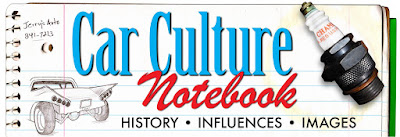 |
EVOLUTION OF A RAT FINK
|
As the popularity of hot rodding developed so did its unique culture, with magazines and associations created to support its fans. In the process, hot rodding created its own identifying style of vehicle designs, artwork, and fashion. Over the years, the dynamic force grew to include car builders Lyle Fisk and Dean Jeffries, customizers George and Sam Barris, and artists Kenny “Von Dutch” Howard and Robert Williams. Motorcycle clubs, surfing, and other outsider lifestyles were infused into the scene, forming a distinct American “Kustom Kulture”.
 |
A lineup of Rat Fink decal imposters. |
 |
Pinstriping became a major part of Ed Roth's hot rod customizing business. |
 |
Roth and Baron, the Crazy Painters. |
Roth entered the Weirdo business the following year after a car club commissioned him to paint caricatures of each member on t-shirts. Roth and Crozier were soon deluged with requests from other clubs. Almost overnight, a good part of their business became Weirdo painted customized t-shirts, printed silkscreened versions, and water slide decals. The sharp-toothed, grinning Rat Fink became Roth’s most successful cartoon design. Although he is usually associated with creating the iconic pot-bellied rodent, its origin was the influence of other artists.
 |
Ed “Big Daddy” Roth and his first Rat Fink model kit. |
 |
Rick Griffith designed many of Roth's ads. |
From 1963-1965 Rat Fink’s popularity spawned an extensive line of plastic model kits produced by Revell Model Company. The success inspired many other companies to produce similar Weirdo model kits, decals, and shirt designs. Hawk produced a popular model line of bulging eyed monsters called Weird-Ohs. Designed by Bill Campbell, the line spun-off trading cards, decals, and plastic figures.
 |
The Rat's Hole's bold rip off of Rat Fink. |
The excitement created by the Weirdo scene started to fizzle out by 1964. One major contributor to its demise was The Beatles’ first visit to the United States. America became obsessed with the “Fab Four” and the ensuing “British Invasion”. Another factor was that hot rodding was becoming acknowledged as a professional organized sport, and less of an outsider activity.
 |
Roth wearing a hillbilly crash helmet. |
Although Ed Roth passed away in 2001 his Rat Fink lives on in the thriving world of Kustom Kulture, with influences found at car shows, art galleries, and tattoo parlors. A future issue of Car Culture Notebook will feature a review of his custom show cars.
• • •
SOURCES:
SOURCES:
“The Biography of Ed ‘Big Daddy’ Roth.” Rat Fink: Official Site of Ed “Big Daddy” Roth. http://www.ratfink.com/big-daddy-roth-bio.php . Retrieved June 15, 2017
“Edward Roth, Big Daddy Who Was the Hot Rod Idol of 1960’s Teenagers, Dies at 69.” The New York Times, April 7, 2001. http://www.nytimes.com/2001/04/07/us/edward-roth-big-daddy-who-was-the-hot-rod-idol-of-1960-s-teenagers-dies-at-69.html">http://www.nytimes.com/2001/04/07/us/edward-roth-big-daddy-who-was-the-hot-rod-idol-of-1960-s-teenagers-dies-at-69.html. Retrieved June 15, 2017.
Rat Fink: The Art of Ed “Big Daddy” Roth. Last Gasp, San Francisco, CA. 2003.


No comments:
Post a Comment